Learn more:
Some notes on the research history - from physiological coherence to internal coherence entrainment
Since the mid '90's, Institute of HeartMath (IHM) not only developed concepts, methods and tools in the field of physiological coherence, but also pioneered a state called internal coherence. Their initial results, conclusions and terminology should be noted in order to have a more complete understanding of how the concept of internal coherence developed since.
IHM recognized that persons, who otherwise have a healthy amount of heart rate variability (HRV), were able to transition themselves into a distinctive low-HRV state, which IHM paraphrased as "deep quiescence", "deeper level of self-management" or "hyperstate", and generally referred to as "internal coherence".
IHM chose not to pursue this line of research, because at that time they found the concept of internal coherence too advanced for their goals, in part because the true nature of this psycho-physiologal state was not fully understood. IHM however concluded that there exists a level of valuable information in the HRV-spectrum which is neither maximally utilized in the relatively coarse autonomic balance assessment ("gamma 1 over 2"), nor even in their more precise method of physiological coherence ("gamma 4 over 3"). This spectral information might theoretically provide clues to a deeper understanding of the low-HRV state, that is, psycho-physiological or internal coherence, but they were not yet clear how.
They further noticed that a sustained low-HRV state, measured as accurate ECG peak-to-peak ("R-R") intervals, is visibly reflected in the ECG spectrum. This nicely illustrated the fact that the HRV is directly linked to the raw ECG data.
| Ref. IHM key papers: |
New Electrophysiological Correlates Associated With Intentional Heart Focus
R. McCraty, M. Atkinson, W. A. Tiller, G. Rein
Subtle Energies 1995;4(3):251-262.
The Coherent Heart
Rollin McCraty, Ph.D., Mike Atkinson, Dana Tomasino, and Raymond Trevor Bradley, Ph.D.
E-book monograph, Institute of Heart Math, 2006
All research on heartmath.org > |
Learn more:
TrigunaMedia
From around 2006, Triguna Media independently developed a general theory of wave coherence (wave matrix theory), and applied this to the psycho-physiology of the heart as well as the brain. For the heart, this led to a definition of internal coherence not based on recognizable or sustained low HRV states per sé, but on the integral (ECG ánd HRV) wave dynamics. Summary of TrigunaMedia research papers here.
This new line of thinking for the first time accurately described the subtler level of information hidden in HRV and ECG spectra which was suspected during the early Heart Math research, providing an entirely new dimension of psycho-physiological assessment and at the same time a concrete basis for internal coherence diagnosis and biofeedback training.
The measurements show that neither the momentary nor the integral levels of "deep quiescence" and "advanced self-management" are simply inversely proportional to the amount of HRV. Namely, if this were the case it would mean that no significant amount of psycho-physiological coherence could be integrated in active, practical life. In other words, there must exist another order of information than that which one can read from plain low ANS output, typically if it concerns a healthy person.
This deeper dimension of information dynamically contained in the HRV spectrum was found and proven by Triguna Media (Frank van den Bovenkamp) to be nature's "secret" of fusing the cardiac slow wave power through Golden Mean / Fibonacci based spectral geometry, creating true emotional coherence. The principle is thought to be virtually identical to how every living form is created, and applied to waves. In other words, it is not a plain reduction of heart rate variability (HRV), but the dynamic, vital and harmonic fusion of HRV waves which generates emotional coherence and true internal coherence in general. It means that the heart can turn itself into a focal point of life-transmitting slow waves by reciprocating the geometric principles of life itself. It is the mathematical formula of what "Heart" truly means. With respect to the HRV-spectrum, the wave discipline creating this fusion is called "Harmonic Inclusiveness" or "Harmonic Entrainment". With respect to psycho-physiology in general it is referred to as harmonic- or geometric synthesis.
Unlike physiological coherence, which is mostly aimed at stress release, Harmonic entrainment is a transformational approach. The goal is definitely not to enter into low-HRV states per sé - rather it is the healthy, dynamic cultivation of transient states through autonomic fusion. The term "trans-fusion" is not a mere pun, as harmonic entrainment is really the wave-discipline of transfusing Spirit into the body!
HeartMath's hypothesis that the sum total HRV wave predicts the ECG signal becomes profound the moment we appreciate the deep, complex and harmonic connection between both. This is why your heart can sometimes carry you away to places you could not possibly have conjured up yourself.
Learn more:
Vedic and modern science
Philosophically, the fact that during a sustained low-HRV state, the nature of harmonic entrainment is not actually measurable does not mean that it is trivial with respect to the low HRV state. Rather, the low-HRV condition is the very proof of the existence of harmonic entrainment in healthy persons, in other words, it indicates a transient coherence state. A very similar line of thinking is found for example in Sankhya philosopy from the Vedic sage Kapilla, (around 1500 BC), where the undetectability of the "sub-stratum" (the presence of consciousness) is considered proof of the existence of its inner dynamics. In fact, both refer to one and the same phenomenon - one axiomatically, the other through measurable wave physiology. An elaborate approach enabling the application of these insights to practical psycho-physiology was given by the Indian philosopher P.R. Sarkar in the late '80's (microvita science). This forms the epistemological framework of internal coherence. Wave Matrix Physics (Frank van den Bovenkamp) is based on Sarkar's theory and also uses axiomatic concepts of Vedic science.
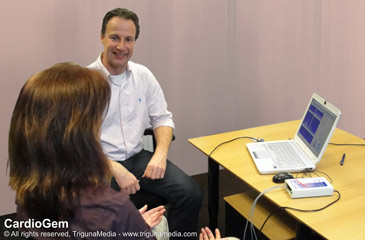
Internal Cardiac Coherence can be a great help with diagnosis,
supporting and enriching your personal evaluation
Internal Cardiac Coherence diagnosis and training fully recognizes and honors the pioneering and signalling work of IHM, and the significance of their initial conclusions, while providing a state of the art method of working with physiological spectra. This is how internal coherence analysis has developed into a professional application in the field of psycho-physiology.
Summary - psycho-physiological coherence: working with a new Science of Consciousness
Physiological coherence diagnosis and training developed by Institute of HeartMath (IHM) is based on the effect of regular breathing on the heart rate. The main use of physiological entrainment is stress release through emotional control. It has a balancing effect on the Autonomic Nervous System.
Initially, the foundations of Internal Coherence or Internal Cardiac Coherence (ICC) were coarsely explored by IHM, but they decided not to deepen this challenging and crucial line of research. Since 2006, TrigunaMedia's approach of psycho-physiological synthesis proved to be a unique way to further evolve this method, thus providing original, exciting and powerful developments in the field. Its distinctive basis follows a transformational approach of harmonic fusion of the slow ("emotional") waves of the Autonomic Nervous System (mathematically, based on fractality optimized by Golden Ratio).
Its use is not primarily aimed at stress release but at entraining a person's access to, and positive use of deep states of emotional quiescence and increased mental serenity, as a diagnosable and entrainable basis for improved emotional and mental self-management with practical benefits.
These dynamic, advanced states together make psycho-physiological synthesis an applied science of Consciousness, aimed at practical diagnosis and training .
See summary of diagnostics and training for health professionals here .
|
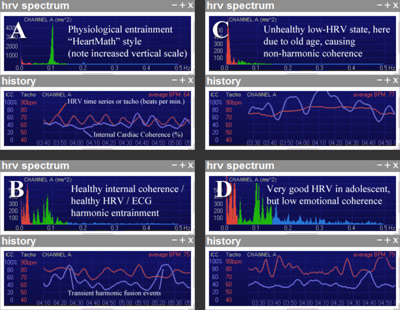
| CardioGem recordings of Physiological (regular breathing) Entrainment (A)as well as Harmonic (ICC) Entrainment (B), producing transient
coherence states) and for comparison, very low- (C) respectively very
high-HRV (D) examples. Click to enlarge. |
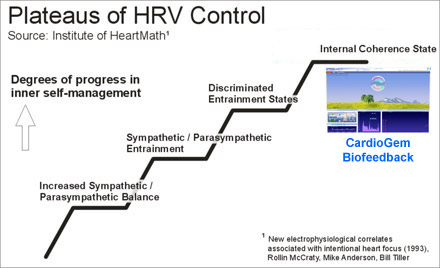
| The first three steps of training increase the level of physiological
(breathing related) coherence, mainly oriented at stress release.
This forms the basis of Internal Cardiac Coherence which
can be entrained through CardioGem biofeedback. |
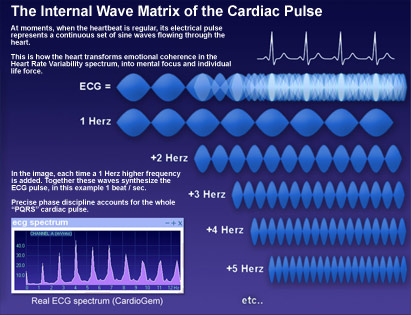
| The Internal- or Sub-Wave Matrix of the Cardiac Pulse. When the heartbeat is regular, a set of continuous sine waves flows through the heart. This
allows the heart to generate and balance emotional coherence and
focused awareness. Click to enlarge. |
|
| "Tree of Life" demonstrating how the optimal geometry of life causes
the slow waves of the Autonomic Nervous System to fuse into a
single purely empathic flow. The positions of the leaves indicate the precise frequencies of the harmonic HRV
spectrum. |
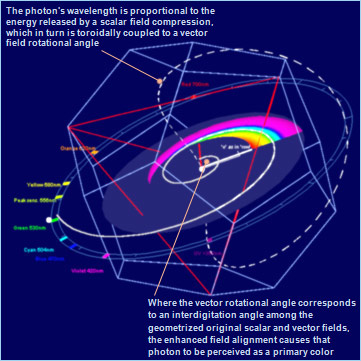
The Geometric Origin of Selective Color Empathy suggests that harmonic entrainment may have played a key role in the evolution of biological vision. Besides the accurate prediction of the wavelengths of the primary colors, the retinal peak sensitivity can also exactly be calculated.
Source: http://science.trigunamedia.com/geocolor |
|
